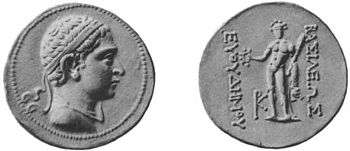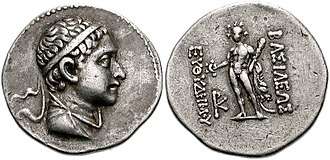Euthydemus II
| Euthydemus II | |
|---|---|
|
Portrait of young Euthydemus II. | |
| Reign | c. 180 BC |
| Predecessor | Demetrius I |
| Successor | Eucratides I |
| Born | c. 200 BC |
| Died |
c. 180 BC Bactria |
| House | Euthydemid |
| Father | Demetrius I |
| Mother | Daughter of Antiochus III |

Silver coin of King Euthydemus II

Euthydemos II (185-180 BCE).
Euthydemus II (Greek: Εὐθύδημος Β΄) was Graeco-Bactrian king; the son of Demetrius I of Bactria, he became king in the 180s BCE, either after his father's death or as a sub-king to him. The style and rare nickel alloys of his coins associates him closely in time with the king Agathocles but their precise relation remains uncertain. Euthydemus is pictured as a boy on his coins and most likely died very young.
He was the last Euthydemid ruler of the Greco-Bactrian Kingdom.
See also
Notes
References
- The Greeks in Bactria and India, W. W. Tarn, Cambridge University Press.
External links
| Preceded by Demetrius I |
Greco-Bactrian king 180s BCE |
Succeeded by Agathocles |
This article is issued from
Wikipedia.
The text is licensed under Creative Commons - Attribution - Sharealike.
Additional terms may apply for the media files.